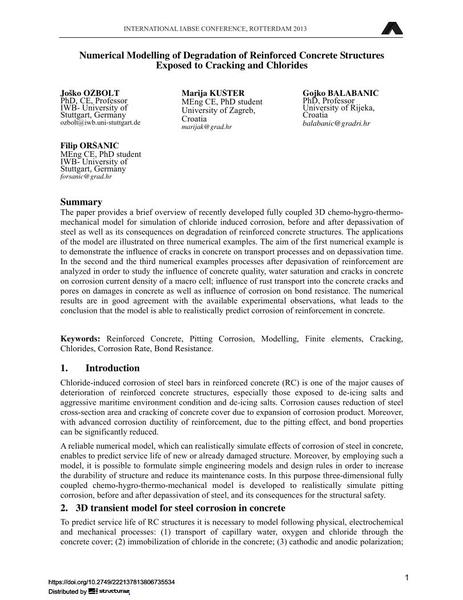Numerical Modelling of Degradation of Reinforced Concrete Structures Exposed to Cracking and Chlorides

|
|
|||||||||||
Bibliografische Angaben
| Autor(en): |
Jośko Ožbolt
Marija Kušter Gojko Balabanić Filip Oršanić |
||||
|---|---|---|---|---|---|
| Medium: | Tagungsbeitrag | ||||
| Sprache(n): | Englisch | ||||
| Tagung: | IABSE Conference: Assessment, Upgrading and Refurbishment of Infrastructures, Rotterdam, The Netherlands, 6-8 May 2013 | ||||
| Veröffentlicht in: | IABSE Conference, Rotterdam, May 2013 | ||||
|
|||||
| Seite(n): | 204-205 | ||||
| Anzahl der Seiten (im PDF): | 8 | ||||
| Jahr: | 2013 | ||||
| DOI: | 10.2749/222137813806735534 | ||||
| Abstrakt: |
The paper provides a brief overview of recently developed fully coupled 3D chemo-hygro-thermo- mechanical model for simulation of chloride induced corrosion, before and after depassivation of steel as well as its consequences on degradation of reinforced concrete structures. The applications of the model are illustrated on three numerical examples. The aim of the first numerical example is to demonstrate the influence of cracks in concrete on transport processes and on depassivation time. In the second and the third numerical examples processes after depasivation of reinforcement are analyzed in order to study the influence of concrete quality, water saturation and cracks in concrete on corrosion current density of a macro cell; influence of rust transport into the concrete cracks and pores on damages in concrete as well as influence of corrosion on bond resistance. The numerical results are in good agreement with the available experimental observations, what leads to the conclusion that the model is able to realistically predict corrosion of reinforcement in concrete. |
||||
| Stichwörter: |
Modellbildung Lochkorrosion Stahlbeton finite Elemente Korrosionsgeschwindigkeit
|
||||
